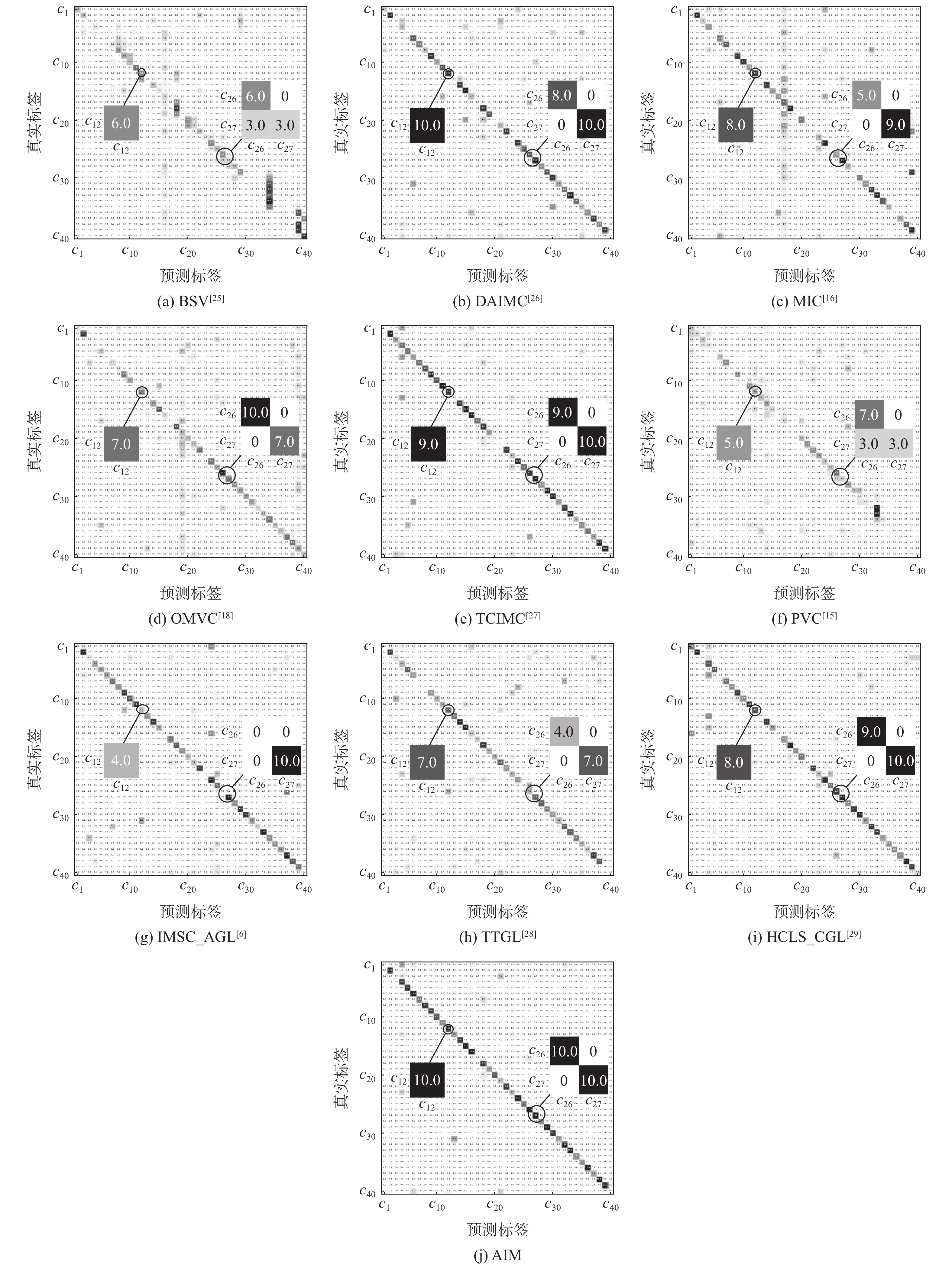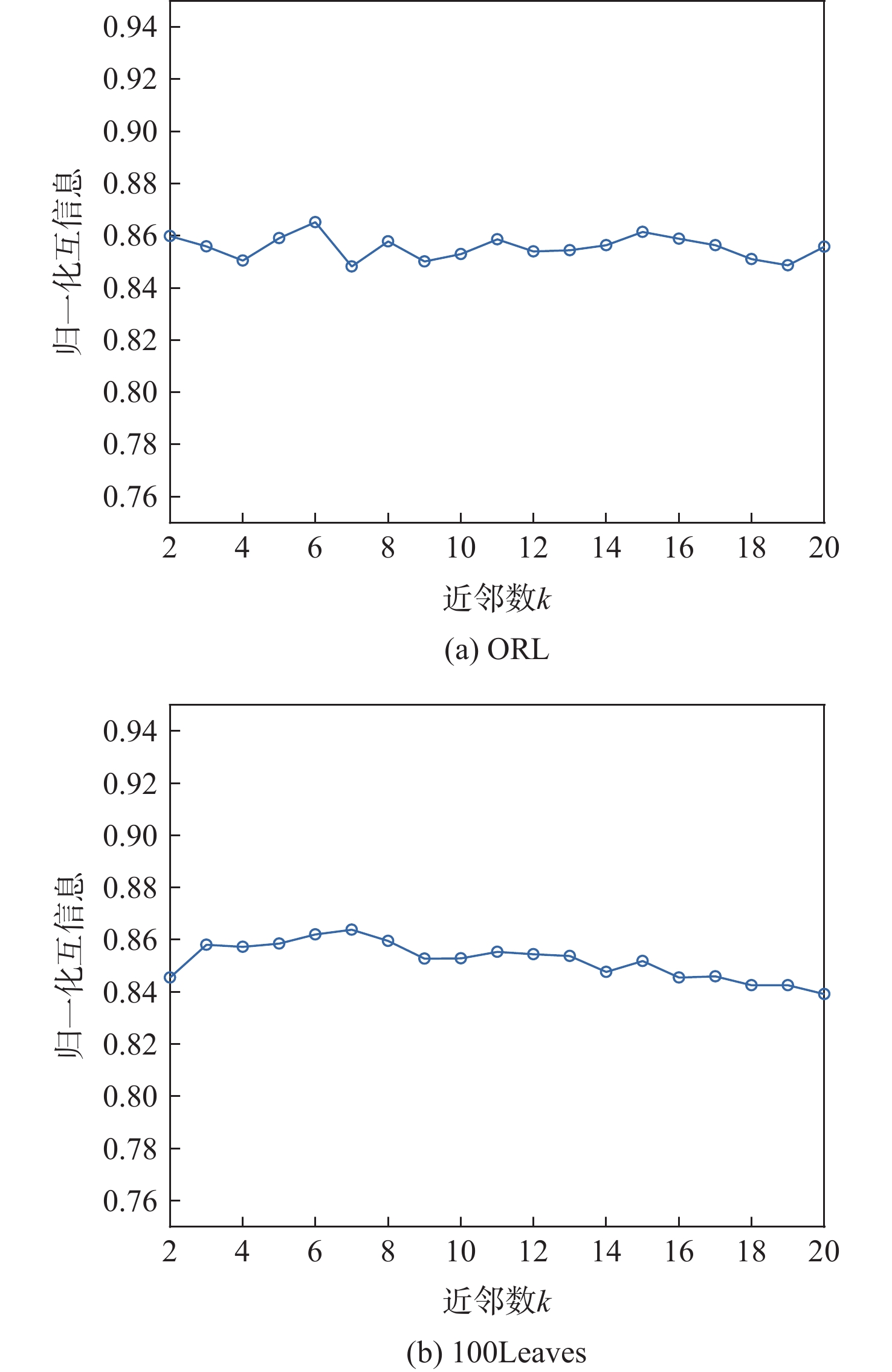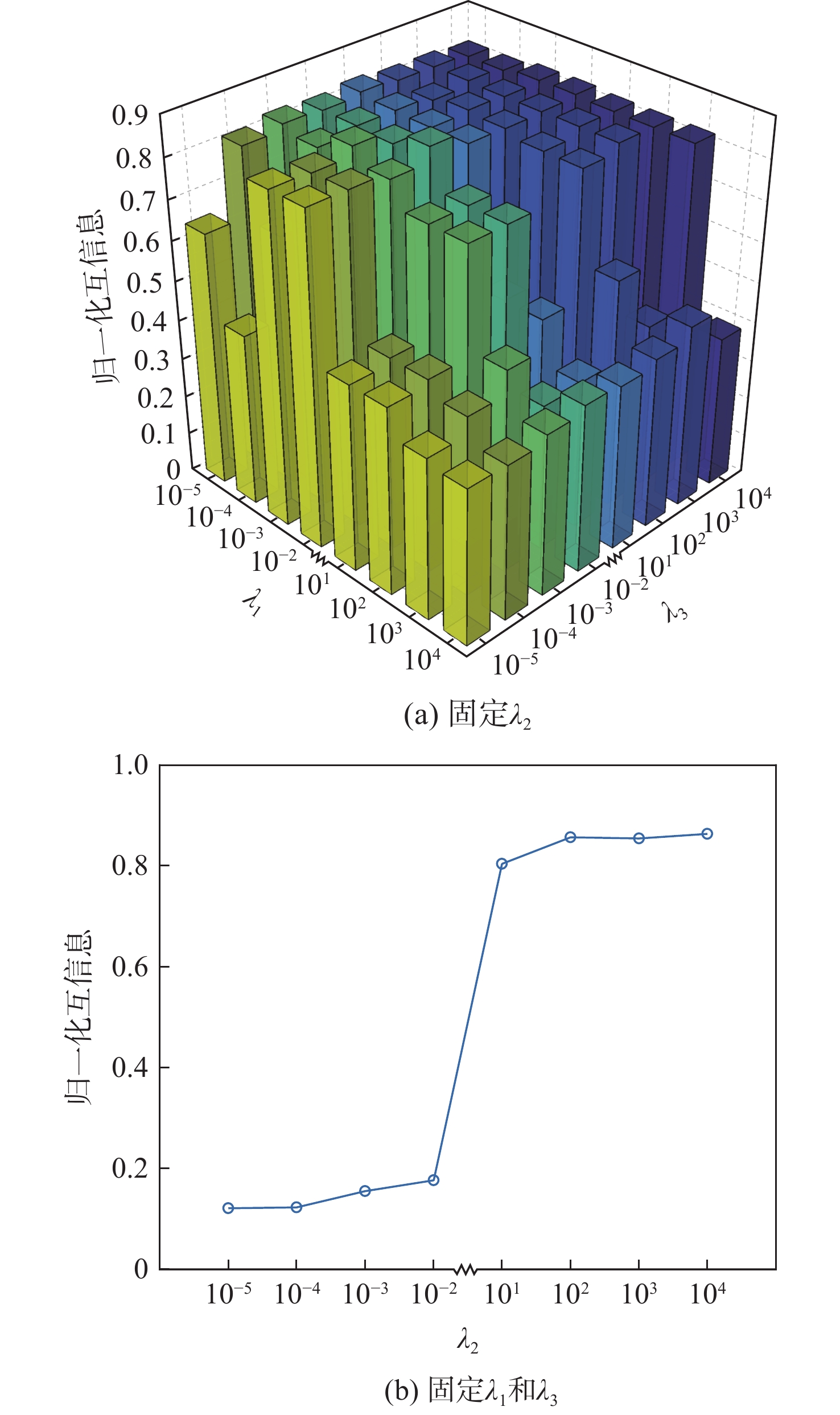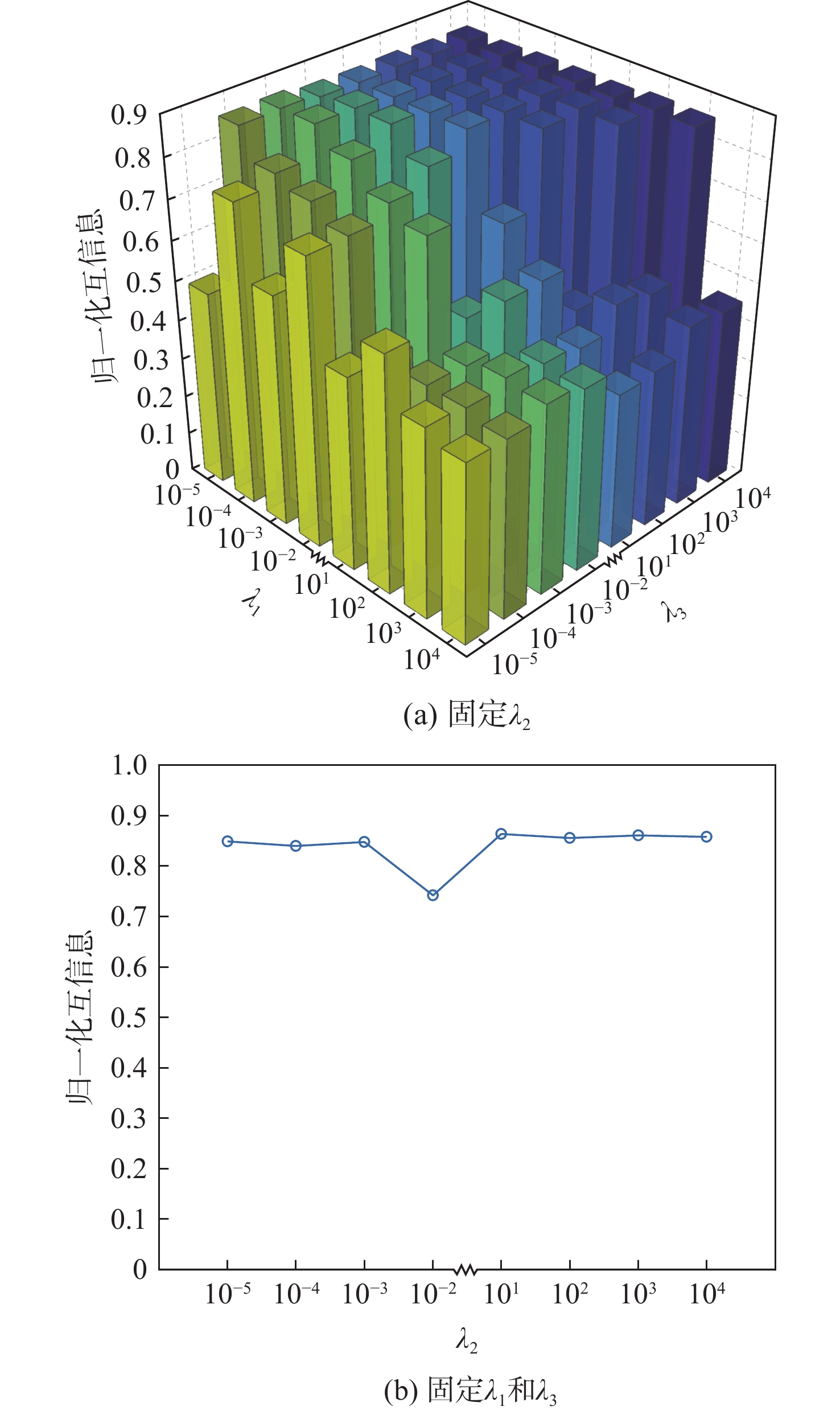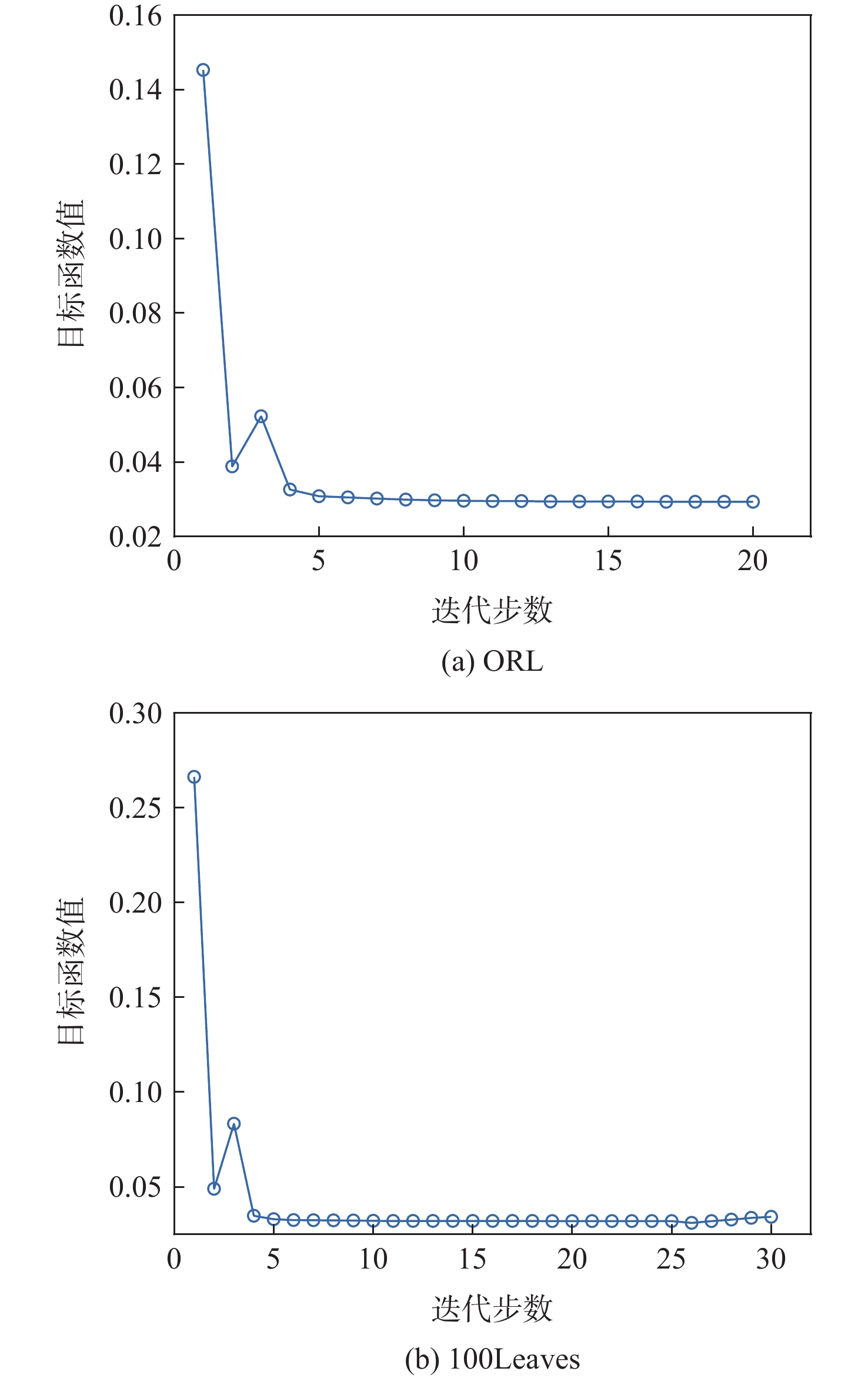-
摘要:
高质量的完备初始图能够有效提高不完备多视角聚类的性能,缺失值填充不恰当会导致初始图丢失数据潜在的结构,同时,各视角的仿射图融合不完全会造成学习到的一致表征缺失视角间的互补信息。为此,提出自适应不完备多视角聚类(AIM)模型。在初始图构建中,AIM模型采用有效视角的相似度均值来填充对应位置的缺失值,以获取数据更加完整的潜在结构,同时引入稀疏约束来提高模型对噪声的鲁棒性;在图优化过程中,引入低秩约束捕获数据的全局结构,通过谱约束增强类内数据间的紧密性,使仿射图具有更清晰的块对角结构,并引入一致性约束最小化各视角的仿射图与一致表征之间的差异来捕获视角间的互补信息,得到具有高鉴别特征的一致鲁棒表征图。与9种不完备多视角聚类方法在真实和多种缺失率下仿真的不完备多视角数据集中进行实验对比,结果表明:AIM模型均获得了最好的聚类性能。
Abstract:A high-quality complete initial graph can effectively improve the performance of incomplete multi-view clustering. However, inappropriate filling of missing values will lead to the initial graph losing the underlying structure of the data, and incomplete fusion of affine graphs of each view will make the unified learned representations miss the complementary information among the views. To address the aforementioned problems, an adaptive incomplete multi-view clustering (AIM) method was proposed in this paper. In the initial graph construction, AIM used the average value of similarity of valid views to fill the missing values at corresponding positions to obtain a complete potential structure of the data and introduced sparsity constraints to improve the robustness of the model to noise. In the graph optimization process, initially, low-rank constraints were introduced to capture the global structure of the data, followed by spectral constraints to enhance the closeness between data within classes to make the affine graph have a clearer block diagonal structure. The consistency constraints were introduced to minimize the differences between the affine graph and the unified representation of each view to capture the complementary information between the views. Ultimately, a unified robust representation graph with high discriminative features was obtained. The experimental comparisons with nine kinds of incomplete multi-view clustering in real and incomplete multi-view datasets simulated under multiple missing rates demonstrate that AIM obtains the best clustering performance.
-
表 1 实验数据集描述
Table 1. Description of experimental dataset
数据集 nv c n dv 类型 BBCSport 2 5 737 3183 /3203 运动文档 3Sources 3 6 416 3560 /3631 /3068 新闻 Two-Moon 2 2 200 200/200 ORL 4 40 400 256/256/256/256 人脸图像 100Leaves 3 100 1600 64/64/64 叶片图像 Scene-15 3 15 4485 20/59/40 场景图像 表 2 不同方法在BBCSport、3Sources和Two-Moon数据集上的精度和归一化互信息
Table 2. Accuracy and NMI of different algorithms on BBCSport, 3Sources, and Two-Moon datasets
方法 精度/% 归一化互信息 Two-Moon BBCSport 3Sources Two-Moon BBCSport 3Sources BSV[25] 79.50 40.99 22.50 0.2701 0.2660 0.0530 DAIMC[26] 73.00 75.16 58.68 0.2203 0.5780 0.4880 MIC[16] 50.50 58.66 43.73 0.0050 0.4626 0.3894 PVC[15] 76.50 44.33 26.45 0.2606 0.1377 0.1377 TCIMC[27] 56.00 67.44 77.16 0.0104 0.5949 0.6763 OMVC[18] 65.50 57.94 49.76 0.0935 0.6635 0.6635 IMSC_AGL[6] 75.50 88.05 65.86 0.1809 0.5376 0.6198 TTGL[28] 84.00 84.93 77.64 0.3879 0.6357 0.6011 HCLS_CGL[29] 72.50 74.76 65.63 0.1516 0.6889 0.5724 AIM 91.00 89.55 86.15 0.5635 0.7095 0.7116 表 3 缺失率为0,0.1,0.3,0.5,0.7,0.9时,不同方法在100Leaves、ORL、Scene-15数据集上的归一化互信息
Table 3. NMI of different algorithms with PER of 0, 0.1, 0.3, 0.5, 0.7, 0.9 on 100Leaves、ORL、Scene-15 datasets
数据集 缺失率 归一化互信息 BSV[25] DAIMC[26] MIC[16] OMVC[18] TCIMC[27] PVC[15] IMSC_AGL[6] TTGL[28] HCLS_CGL[29] AIM 100Leaves 0 0.5417 0.8754 0.8488 0.2350 0.8937 0.6600 0.9355 0.7856 0.8830 0.9536 0.1 0.5363 0.8406 0.8170 0.5659 0.8860 0.5828 0.9247 0.7503 0.8733 0.9303 0.3 0.4747 0.7628 0.7417 0.4952 0.6901 0.5294 0.8834 0.7320 0.8104 0.9035 0.5 0.4359 0.6833 0.6735 0.4615 0.6982 0.4431 0.8381 0.6768 0.7986 0.8625 0.7 0.3961 0.6302 0.6317 0.4354 0.7084 0.3981 0.8215 0.6480 0.7760 0.8405 0.9 0.3552 0.5813 0.5944 0.4700 0.7828 0.3606 0.7663 0.6012 0.7540 0.7876 ORL 0 0.1346 0.7793 0.7869 0.7364 0.8600 0.6550 0.8351 0.7151 0.8382 0.8803 0.1 0.4307 0.7691 0.7515 0.6910 0.8595 0.5700 0.7913 0.6902 0.8244 0.8739 0.3 0.3946 0.7344 0.6331 0.6483 0.8236 0.4600 0.7706 0.6508 0.7932 0.8572 0.5 0.4455 0.7096 0.5761 0.6049 0.8252 0.3550 0.7524 0.5787 0.7610 0.8450 0.7 0.4643 0.6565 0.4910 0.5681 0.7908 0.3225 0.7227 0.5220 0.7384 0.8271 0.9 0.4703 0.6162 0.4233 0.5563 0.7705 0.2050 0.6911 0.5054 0.7003 0.7823 Scene-15 0 0.0074 0.3048 0.3440 0.3262 0.2158 0.3336 0.4203 0.3914 0.3999 0.4634 0.1 0.0058 0.3053 0.3241 0.2772 0.4045 0.3463 0.3994 0.3763 0.3891 0.4482 0.3 0.0076 0.2791 0.2874 0.2540 0.4102 0.2756 0.3858 0.3336 0.3626 0.4315 0.5 0.0075 0.2468 0.2507 0.2180 0.3994 0.2537 0.3720 0.3110 0.2959 0.4020 0.7 0.0079 0.2092 0.2116 0.2356 0.3660 0.2604 0.3533 0.2647 0.3210 0.4053 0.9 0.0088 0.1836 0.1921 0.2198 0.3471 0.2120 0.3382 0.2500 0.3074 0.3677 -
[1] ZHAO J, XIE X J, XU X, et al. Multi-view learning overview: recent progress and new challenges[J]. Information Fusion, 2017, 38: 43-54. doi: 10.1016/j.inffus.2017.02.007 [2] 谢娟英, 丁丽娟. 完全自适应的谱聚类算法[J]. 电子学报, 2019, 47(5): 1000-1008.XIE J Y, DING L J. The true self-adaptive spectral clustering algorithms[J]. Acta Electronica Sinica, 2019, 47(5): 1000-1008(in Chinese). [3] XIA K J, GU X Q, ZHANG Y D. Oriented grouping-constrained spectral clustering for medical imaging segmentation[J]. Multimedia Systems, 2020, 26(1): 27-36. doi: 10.1007/s00530-019-00626-8 [4] SHARMA K K, SEAL A. Multi-view spectral clustering for uncertain objects[J]. Information Sciences, 2021, 547: 723-745. doi: 10.1016/j.ins.2020.08.080 [5] GAO H C, NIE F P, LI X L, et al. Multi-view subspace clustering[C]//Proceedings of the IEEE International Conference on Computer Vision. Piscataway: IEEE Press, 2015: 4238-4246. [6] WEN J, XU Y, LIU H. Incomplete multiview spectral clustering with adaptive graph learning[J]. IEEE Transactions on Cybernetics, 2020, 50(4): 1418-1429. doi: 10.1109/TCYB.2018.2884715 [7] NISHOM M. Perbandingan akurasi Euclidean distance, Minkowski distance, Dan Manhattan distance pada algoritma K-means clustering berbasis Chi-square[J]. Jurnal Informatika: Jurnal Pengembangan IT, 2019, 4(1): 20-24. doi: 10.30591/jpit.v4i1.1253 [8] YIN J, SUN S L. Incomplete multi-view clustering with cosine similarity[J]. Pattern Recognition, 2022, 123: 108371. doi: 10.1016/j.patcog.2021.108371 [9] DING X J, LIU J, YANG F, et al. Random compact Gaussian kernel: application to ELM classification and regression[J]. Knowledge-Based Systems, 2021, 217: 106848. doi: 10.1016/j.knosys.2021.106848 [10] SHANG R H, ZHANG Z, JIAO L C, et al. Self-representation based dual-graph regularized feature selection clustering[J]. Neurocomputing, 2016, 171: 1242-1253. doi: 10.1016/j.neucom.2015.07.068 [11] WENG L B, DORNAIKA F, JIN Z. Graph construction based on data self-representativeness and Laplacian smoothness[J]. Neurocomputing, 2016, 207: 476-487. doi: 10.1016/j.neucom.2016.05.021 [12] WANG Y, ZHANG W J, WU L, et al. Iterative views agreement: an iterative low-rank based structured optimization method to multi-view spectral clustering[C]//Proceedings of the 25th International Joint Conference on Artificial Intelligence. New York: ACM, 2016: 2153-2159. [13] WANG Y, WU L, LIN X M, et al. Multiview spectral clustering via structured low-rank matrix factorization[J]. IEEE Transactions on Neural Networks and Learning Systems, 2018, 29(10): 4833-4843. [14] ZHANG P, LIU X W, XIONG J, et al. Consensus one-step multi-view subspace clustering[J]. IEEE Transactions on Knowledge and Data Engineering, 2020, 34(10): 4676-4689. [15] LI S Y, JIANG Y, ZHOU Z H. Partial multi-view clustering[C]//Proceedings of the AAAI Conference on Artificial Intelligence. Palo Alto: AAAI Press, 2014: 1968-1974. [16] SHAO W, HE L. Multiple incomplete views clustering via weighted nonnegative matrix factorization with l2,1 regularization[C]//Proceedings of the European Conference on Machine Learning and Principles and Practice of Knowledge Discovery in Databases. Berlin: Springer, 2017: 318-334. [17] GAO H, PENG Y X, JIAN S L. Incomplete multi-view clustering[C]//Proceedings of the 9th IFIP TC 12 International Conference on Intelligent Information Processing VIII. Berlin: Springer, 2016: 245-255. [18] SHAO W X, HE L F, LU C T, et al. Online multi-view clustering with incomplete views[C]//Proceedings of the IEEE International Conference on Big Data. Piscataway: IEEE Press, 2016: 1012-1017. [19] CHEN J, YANG S X, PENG X, et al. Augmented sparse representation for incomplete multiview clustering[J]. IEEE Transactions on Neural Networks and Learning Systems, 2024, 35(3): 4058-4071. doi: 10.1109/TNNLS.2022.3201699 [20] LIU X W, LI M M, TANG C, et al. Efficient and effective regularized incomplete multi-view clustering[J]. IEEE Transactions on Pattern Analysis and Machine Intelligence, 2021, 43(8): 2634-2646. [21] TRIVEDI A, RAI P, DAUMÉ H. Multiview clustering with incomplete views[C]//Proceedings of the Conference and Workshop on Neural Information Processing Systems workshop. Cambridge: MIT Press, 2010: 1-8. [22] LIU G C, LIN Z C, YAN S C, et al. Robust recovery of subspace structures by low-rank representation[J]. IEEE Transactions on Pattern Analysis and Machine Intelligence, 2013, 35(1): 171-184. doi: 10.1109/TPAMI.2012.88 [23] CAI J F, CANDÈS E J, SHEN Z W. A singular value thresholding algorithm for matrix completion[J]. SIAM Journal on Optimization, 2010, 20(4): 1956-1982. doi: 10.1137/080738970 [24] XIAO X L, GONG Y J, HUA Z Y, et al. On reliable multi-view affinity learning for subspace clustering[J]. IEEE Transactions on Multimedia, 2020, 23: 4555-4566. [25] ZHAO H D, LIU H F, FU Y. Incomplete multi-modal visual data grouping[C]//Proceedings of the 25th International Joint Conference on Artificial Intelligence. New York: ACM, 2016: 2392-2398. [26] HU M L, CHEN S C. Doubly aligned incomplete multi-view clustering[EB/OL]. (2019-03-07)[2023-04-01]. https://arxiv.org/abs/1903.02785v1. [27] XIA W, GAO Q X, WANG Q Q, et al. Tensor completion-based incomplete multiview clustering[J]. IEEE Transactions on Cybernetics, 2022, 52(12): 13635-13644. doi: 10.1109/TCYB.2021.3140068 [28] ZHANG Z, HE W J. Tensorized topological graph learning for generalized incomplete multi-view clustering[J]. Information Fusion, 2023, 100: 101914. doi: 10.1016/j.inffus.2023.101914 [29] WEN J, LIU C L, XU G H, et al. Highly confident local structure based consensus graph learning for incomplete multi-view clustering[C]//Proceedings of the IEEE/CVF Conference on Computer Vision and Pattern Recognition. Piscataway: IEEE Press, 2023: 15712-15721. -







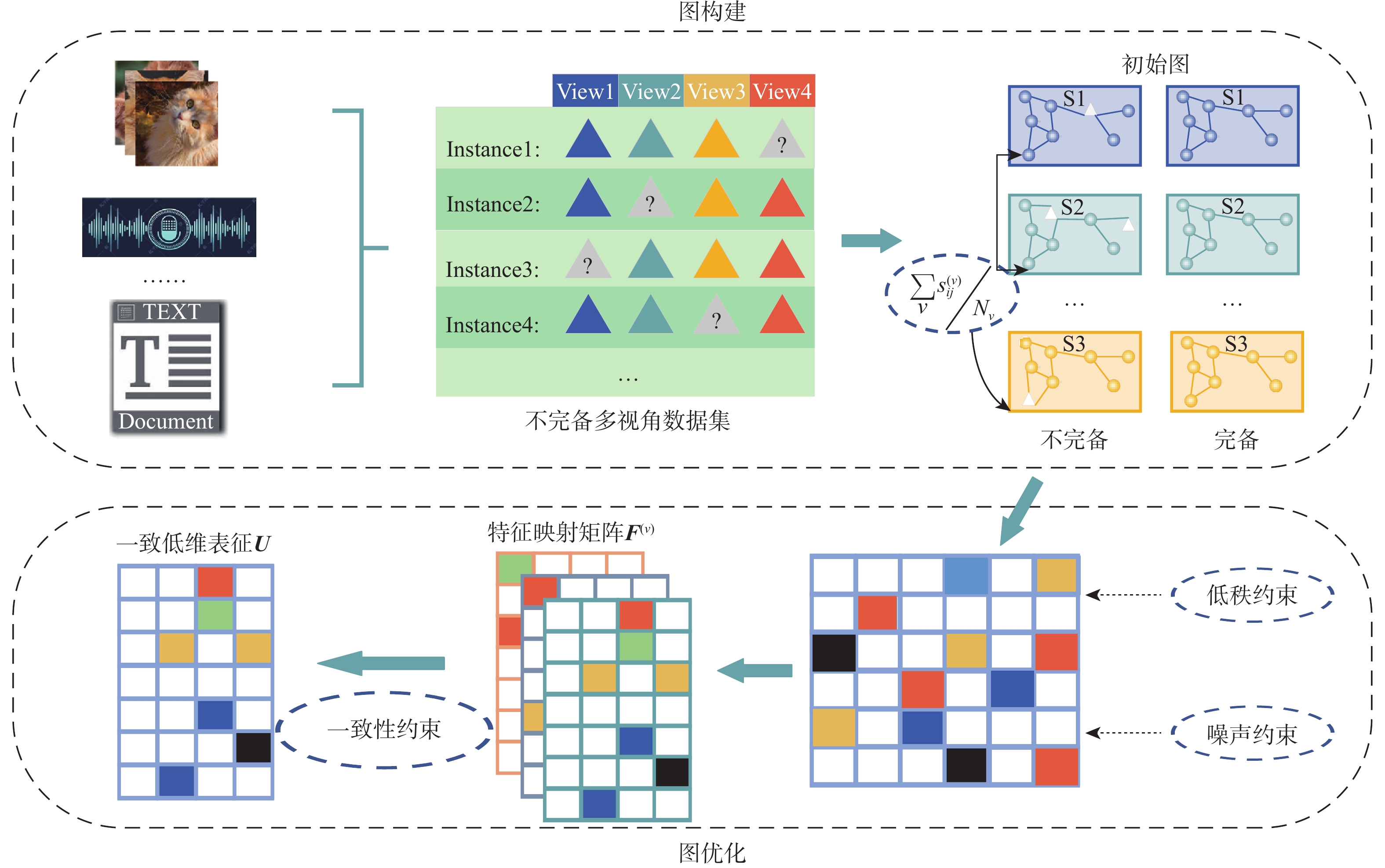
 下载:
下载:


